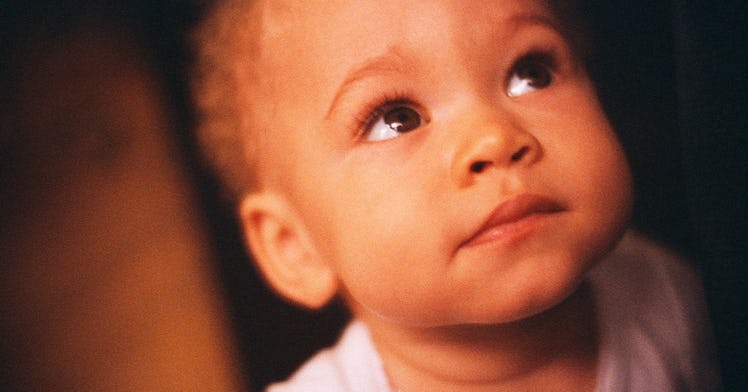The Only 4-Month Milestones That Matter
Most parents overdo the whole milestone thing in the fourth month. Stop stressing out and focus on the two (just two!) developmental moments that really matter.

Many parents assume that developmental milestones should be sequential. But infant milestones aren’t distinct achievements that children hit, unlocking abilities as if leveling up in a video game. Some babies arrive at 4-month milestones early, while hitting other milestones late. Some babies may leap over a milestone entirely. There’s no reason for parents to stress out over most developmental milestones — it’s always best to look at a child’s development from a holistic perspective, rather than through a subset of specific skills. After all, your 4-month-old isn’t just an avatar collecting a bunch of cool abilities — even if cool abilities develop in droves at this age.
That said, there is quality guidance available for understanding your baby’s growth and development. In February 2022, the Centers for Disease Control and Prevention (CDC) and the American Academy of Pediatrics overhauled the pediatric milestone checklist. This process included adding developmental milestones for 15-month-olds and 30-month-olds, and revamping other milestone charts to reflect things most children (75% or more) can do by a certain age. To help parents track milestones on their own, the CDC has released a free Milestone Tracker mobile app, a Digital Online Checklist, and a PDF checklist that parents can download and print.
In the fourth month of life, infants become natural experimenters, and while their experiments can be disruptive — “What happens when I drop my pacifier this time?” — they are important. By 4-months-old, babies start to learn about their world and show you what they know.
4-Month Milestone #1: Baby Should Be Communicative
Baby communication is a bit more subtle than you might imagine. Absent the capacity for language, your kid has to rely on the tools they do have to get your attention. What are they? Crying, cooing, grabbing, dropping, kicking, giggling, making faces, and looking.
These methods of communication aren’t always pleasant. Picking up the dropped toy gets old somewhere around the 10th time, and crying is never fun. But these behaviors are important because they signal that your baby has developed some important skills.
Smiling at you to get you to smile back means they are becoming aware of their personhood. Dropping objects for you to pick up means they’re gaining an understanding of cause and effect. Watching your face and listening to your voice before making their own response means that they’re beginning to understand your emotions.
When a baby becomes more communicative, in their special baby way, it means their motor development and cognitive development are beginning to work in concert. As these systems come together, they connect your baby to a wider world outside themselves.
Most important, not every baby will communicate in the same way. Look for your baby’s special mode of communication.
Red Flags: If your baby isn’t following objects with their eyes, or doesn’t vocalize or react to your face by 4 months, it could be indicative of an issue with cognitive development. Although there’s no reason to be terribly worried if your baby’s health is otherwise sound, it’s definitely something you’ll want to discuss with your pediatrician
What You Shouldn’t Stress About: Sure, babies communicate, but don’t look for them to speak or sign words yet. Mostly, they’ll just want to make sure they have your attention. Give it to them, for sure, but also let them lead. There’s no sense in trying to teach them more words through DVDs or flashcards. Those things won’t help. Just talk to them as you normally would.
4-Month Milestone #2: Baby Should Be Stronger
Physically, typical babies’ motor systems seem to “turn on” in a specific way — from head to toe and from the middle of their body outwards. Which is to say they develop control and dexterity over these systems in a top-down, middle-out manner. As they practice using all these muscles, from neck-to-core to legs, and from arms to hands to fingers, they will become stronger.
It’s not as if your baby will be lifting weights at 4 months, but they should be using their systems in concert to explore their world. They might push themselves up and be able to reach out during tummy time. They might keep their arms taut and pull as parents help them into a sitting position. They will look fairly stable and be able to look around freely, reaching out to play and explore. And this is the time when they will be able to support themselves without their legs buckling when a parent holds them up in a standing position.
Red Flags: A baby with erratic movements who does not seem to have control over their head may not be developing typically. Babies who are struggling with physical development might have a tendency to keep their limbs tucked up and may seem listless and floppy.
What You Shouldn’t Stress About: At 4 months, there’s no need for your baby to need to know how to roll over. If they are otherwise strong and alert, the movement will eventually come, as will the ability to sit independently and eventually move around on their own.
Non-Milestone Moments in Baby’s Fourth Month
Four-month-olds should be taking a couple of naps during the day, along with a full night of sleep. Although that sounds great, babies aren’t soundless sleepers. Grunts, short cries, and various other sounds occur with regularity. They will naturally wake between sleep cycles just like adults. So before you rush in, see if they can settle on their own.
Also, take a look at your baby’s eyes. Weirdly, the color might be changing a bit, and you may not know what color their eyes will settle on for a few more weeks. This is natural, if a little sad. Goodbye, baby blues.
This article was originally published on